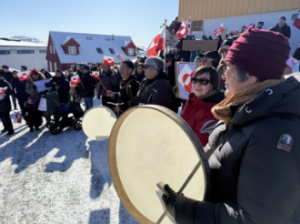Tensions on the island have been rekindled by Donald Trump’s previous interest in purchasing Greenland, sparking rallies around the country. Thousands of Greenlanders gathered in the capital city of Nuuk for what is reportedly the largest protest in the nation’s history, escalating what began as a contentious statement in 2019 into a full-scale national outrage. Anger and frustration are the driving forces behind this movement, which boldly tells the former US president that Greenland is not for sale.

Thousands of Greenlanders demonstrated their unwavering solidarity and resolve by flooding the streets of Nuuk, demonstrating that their sovereignty cannot be compromised. Trump’s persistent efforts to seize Greenland, a region with substantial geopolitical and strategic significance, sparked the demonstrations, which have since expanded to neighboring cities on the island. Protesters displayed signs with strong statements like “Greenland belongs to Greenlanders” and “We’re not for sale,” highlighting the widespread belief that the island’s destiny should be left up to its citizens. People of different ages, socioeconomic origins, and political affiliations participated in the demonstrations, indicating a national consensus against the concept of foreign ownership or control.

Múte B. Egede, the acting prime minister of Greenland, has been a strong critic of Trump’s plan. “Greenland is ours,” Egede adamantly stated in a passionate address. “We are not for sale,” he said, stressing that it is intolerable for any foreign country to put pressure on the island to be bought. His remarks supported Greenland’s position on preserving its independence and autonomy and mirrored the protesters’ views. Many Greenlanders, who believed that the plan disregarded their history, culture, and right to self-determination, found great resonance in Egede’s remarks. His leadership during this crisis has been a source of pride for many, and he has received great praise for refusing to consider any talks with the U.S. administration regarding the island’s future.
The demonstrations are a reaction to Donald Trump’s handling of the issue as well as the possibility of Greenland being sold. Numerous protesters expressed their annoyance at what they saw as Trump’s contempt for the Greenlandic people. “He hasn’t shown good behavior,” one demonstrator said, alluding to Trump’s casual and sometimes contemptuous remarks about the island’s sovereignty. Another protester also brought up the fact that not all Greenlanders have a positive opinion of the United States, arguing that the plan to sell the island was not only improper but also indicative of a larger misunderstanding between the United States and the people of Greenland. Deep worries about the loss of Greenland’s autonomy and cultural identity have been raised by the prospect of a foreign power—especially one as strong as the United States—trying to dictate their future.

Both the scale of the demonstrations and the variety of political backing they attracted made them noteworthy. Greenland leaders from all political stripes came together to oppose Trump’s plan, demonstrating that the desire to preserve Greenland’s sovereignty cuts across party lines. The message was the same for both conservative lawmakers and left-wing activists: Greenland belongs to its people, and it is their right to determine its future, not outside forces. The significance of national self-determination in the face of outside influences is shown by this uncommon political unanimity among Greenlanders. It emphasizes a long-standing determination to protect the island’s sovereignty and thwart any efforts to compromise it.
A worldwide discussion about Greenland’s future was spurred by Trump’s interest in purchasing the island. Some analysts conjectured that the island’s strategic location and abundance of natural resources made it a desirable asset for the US, while others denounced the idea as a flimsy attempt to impose authority over the region. According to numerous international experts, Greenland’s rejection of Trump’s proposal is a strong declaration in support of territorial integrity and indigenous rights.
The difficulties that many small, isolated countries confront in preserving their independence in a world where geopolitics frequently determines the fate of territory have also been highlighted by Greenland’s adamant opposition to any kind of sale or foreign control. Although Greenland already enjoys a special political position as a component of the Kingdom of Denmark, its people are increasingly claiming the right to shape their own destiny.
Ultimately, Greenland’s response—both from the streets and from governmental figures—has been unambiguous: the island is committed to maintaining its independence and defending its sovereignty. The demonstrations have demonstrated that, regardless of how strong the nation supporting them may be, Greenlanders will not be readily influenced by outside interests. For years to come, this episode will probably influence the political conversation around Greenland’s future.
The island’s adamant rejection of Trump’s plan shows its steadfast adherence to independence and self-determination, principles that are highly valued by Greenlanders. The massive demonstrations serve as a potent reminder of how crucial it is to uphold countries’ rights to self-govern without external intervention. The message of Greenland is straightforward but profound: Greenland is not for sale.
